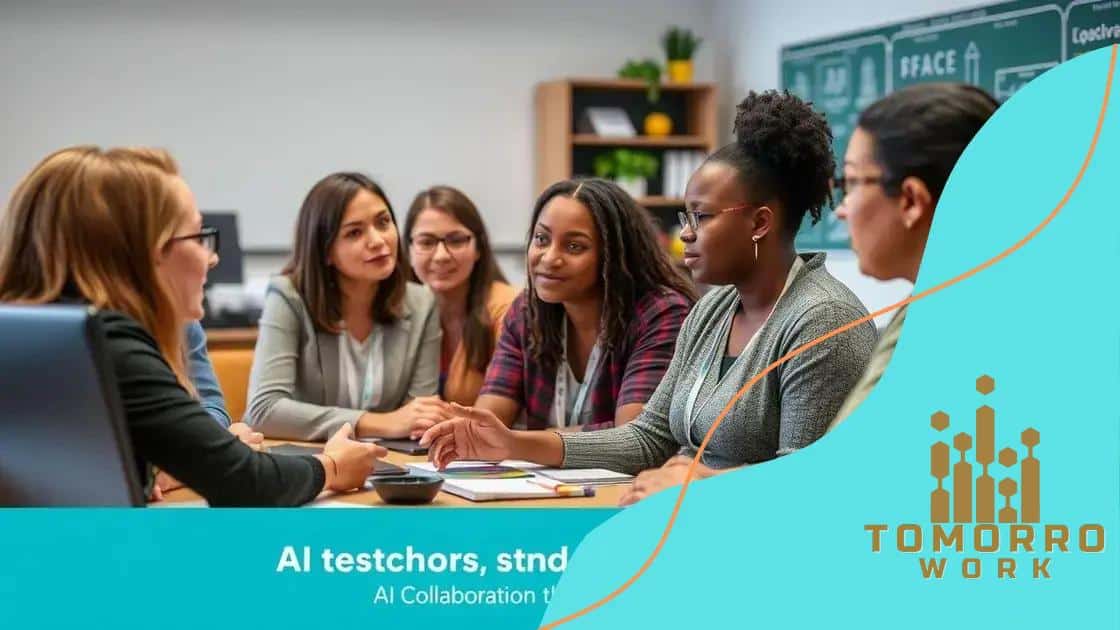How AI is changing the future of student assessments

Advertisements
AI is changing the future of student assessments by providing personalized learning paths, automating grading processes, and improving educational outcomes through data analysis.
How AI is changing the future of student assessments is something more educators are considering. Have you thought about how technology could reshape traditional testing?
Advertisements
Understanding AI in Education
Understanding how AI in education works is key to leveraging its benefits for students and educators alike. With the rise of technology, educators are increasingly exploring innovative ways to enhance learning experiences.
What is AI in Education?
AI in education refers to the use of artificial intelligence tools and systems to support and enhance the learning process. It can analyze vast amounts of data, recommend personalized learning experiences, and even grade assignments with remarkable accuracy.
Advantages of Integrating AI
Here are some benefits of incorporating AI in educational settings:
Advertisements
- Personalized Learning: Tailoring educational experiences to meet individual student needs.
- Efficiency: Automating administrative tasks like grading, allowing teachers more time to focus on instruction.
- Engagement: Interactive learning tools can keep students motivated and involved.
- Data-Driven Insights: AI systems can provide valuable data on student performance, helping educators make informed decisions.
The role of AI is expanding rapidly in the classroom. Students can interact with intelligent tutoring systems that adapt to their learning pace. For instance, if a student struggles with a specific topic, the system can offer supplementary materials and quizzes to strengthen their understanding.
Moreover, schools are using AI to track attendance and monitor engagement levels, which helps identify students who may need additional support. The technology not only streamlines processes but also creates a richer educational environment.
In summary, the integration of AI in education opens new avenues for learning and teaching, making it essential for educators to embrace these changes.
Benefits of AI in Student Assessments
The benefits of AI in student assessments are transforming educational practices. By integrating technology, educators can significantly improve the assessment process, making it more efficient and personalized.
Enhanced Accuracy in Grading
One major advantage of using AI is its ability to grade assignments with high precision. Unlike traditional methods, AI systems can assess students’ work consistently and objectively. This reduces the chances of human error and bias, ensuring fairer outcomes.
Personalized Feedback for Students
Through AI, students receive immediate and tailored feedback on their performance. Instead of waiting for days or weeks for grades, they can understand their strengths and weaknesses right away. This rapid response helps in adjusting their study strategies effectively.
- Real-time analysis of student performance.
- Focus on individual learning gaps.
- Suggestions for improvement based on data.
Moreover, AI can help educators identify trends in student performance over time. By analyzing data collected from various assignments, teachers can pinpoint classroom-wide needs or areas where students struggle collectively. This information is invaluable for adjusting instruction methods to better support students.
Another key benefit is the decrease in administrative workload for teachers. Assessing large groups of students can be time-consuming. With AI, much of this workload is automated, allowing teachers to devote more time to engaging with their students in meaningful ways.
Furthermore, AI tools can help design assessments that adapt to student responses. If a student excels, the assessment can increase in difficulty. Conversely, if a student struggles, the system can offer simpler tasks to help build their confidence.
In essence, leveraging AI in student assessments not only enhances the quality of education but also supports teachers and students in attaining better results.
Challenges of Implementing AI

Implementing AI in education comes with several challenges that need thoughtful consideration. While the benefits are substantial, understanding the hurdles can lead to better solutions and smoother transitions.
Technological Barriers
One of the major challenges is ensuring that the necessary technology is accessible to all students and schools. Many institutions may not have the required hardware or reliable internet access to effectively implement AI systems. This digital divide can create inequities in the education system.
Training Educators
Another significant hurdle is the need for proper training for educators. Without a solid understanding of how to use AI tools, teachers may struggle to integrate them into their classrooms. Continuous professional development is essential for teachers to feel confident and competent in implementing these technologies.
- Understanding AI functionalities.
- Developing new teaching strategies.
- Utilizing data analytics for student assessments.
Additionally, there can be resistance from educators and stakeholders. Change is often met with skepticism, especially when it involves new technologies. Building trust and demonstrating the effectiveness of AI solutions is vital for wider acceptance.
Data privacy is another concern that cannot be overlooked. With the use of AI, vast amounts of student data are collected and analyzed. Ensuring that this data is protected from breaches and used ethically is paramount. Schools must establish clear policies to safeguard student information.
Furthermore, there is the issue of potential bias in AI algorithms. If these systems are not carefully designed, they may reinforce existing biases in assessments and decision-making processes. Continuous monitoring and updating of algorithms are necessary to mitigate these risks.
In facing these challenges, collaboration among educators, tech developers, and policymakers is essential. By working together, they can create strategies that minimize obstacles and maximize the positive impacts of AI in education.
Real-World Applications of AI in Testing
Real-world applications of AI in testing are making significant impacts in education today. Schools and universities are increasingly using AI tools to enhance assessment methods and improve learning outcomes.
Adaptive Testing
One effective application of AI is in adaptive testing. This form of assessment adjusts the difficulty of questions based on a student’s performance. If a student answers correctly, the test presents more challenging questions. If they struggle, easier questions follow. This approach allows for a more personalized assessment experience.
Automated Essay Scoring
Another exciting use of AI is in automated essay scoring. Programs analyze student essays and provide feedback on structure, grammar, and content quality. This not only gives students quick responses but also helps teachers manage their grading workload.
- Consistency in scoring across all students.
- Identification of common mistakes for targeted teaching.
- Reduction of grading bias, leading to fairer evaluation.
Additionally, AI is being utilized for predicting student performance. By analyzing past assessment data, AI systems can forecast future outcomes, allowing teachers to implement timely interventions for students who may need extra help.
Some schools are also incorporating AI chatbots into their assessment processes. These chatbots can administer quizzes, answer student questions, and offer explanations in real-time, making learning more engaging.
The integration of AI in testing is also evident in standardized tests. Organizations are using AI to streamline the test-taking process, ensuring better security and reducing the chances of cheating by employing advanced monitoring technologies.
As these applications demonstrate, the implementation of AI in testing continues to evolve and offers numerous benefits. Schools that embrace these technologies can create a more effective learning environment for students.
Future Trends of AI in Education
The future trends of AI in education are exciting and filled with potential. As technology continues to evolve, its integration into educational settings is likely to deepen, transforming how students learn and how teachers educate.
Personalized Learning Experiences
One significant trend is the rise of personalized learning experiences. AI technology can analyze data on individual student performance and learning styles. This helps create custom learning paths that cater to each student’s unique needs.
Intelligent Tutoring Systems
Another upcoming trend is the implementation of intelligent tutoring systems. These systems use AI to provide one-on-one support for students, helping them tackle difficult concepts at their own pace. They can offer instant feedback and additional resources based on the student’s understanding.
- Adaptive lessons that align with learner progress.
- Instant feedback mechanisms to enhance learning.
- Tailored resources that match individual interests.
Moreover, AI is likely to improve administrative functions in schools. Tasks such as scheduling, grading, and student assessments could become more efficient, allowing educators to focus on teaching rather than paperwork.
There’s also the potential for enhanced collaboration through AI. Virtual classrooms and learning environments can bring together students and teachers from around the world, fostering diverse learning experiences. AI can facilitate group projects, connecting international students with shared interests.
Additionally, we can expect AI to play a crucial role in preparing students for the future workforce. By integrating real-world problem solving and critical thinking skills into learning, AI can help students develop competencies that are essential in today’s job market.
As we look ahead, the possibilities for AI in education are vast. Embracing these trends could lead to a more inclusive, engaging, and effective learning environment for students of all backgrounds.
FAQ – Frequently Asked Questions about AI in Education
What are the main benefits of using AI in education?
AI can provide personalized learning experiences, automate grading, and analyze student performance to enhance educational outcomes.
How does AI personalize learning for students?
AI analyzes data on individual student performance and learning styles to create tailored educational paths, ensuring each student receives the support they need.
What challenges might schools face when implementing AI?
Challenges include ensuring equitable access to technology, providing proper teacher training, and addressing data privacy concerns.
Can AI tools really improve student assessments?
Yes, AI tools can enhance assessment accuracy, provide instant feedback, and help educators identify learning trends for better teaching strategies.





